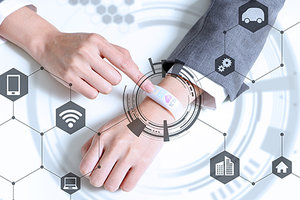Wearable multisensory devices (e.g., the Oura Ring, smartwatches, activity trackers, Garmin) measure a broad range of physiologic processes in real time and are increasingly popular. Let's look at their application to the chiropractic practice, including the accuracy of the data they provide.
Rest / Sleep
Rest, one of the "five factors of health," is essential for recovery, healing and wellness. Lack of sleep is a contributing factor to many heath issues, such as weight gain, chronic systemic inflammation, cardiovascular disease, immunodeficiency and cognitive decline. Wearable sensors can be helpful in tracking sleep quality, quantity and sleep cycles.
For sleep quality and quantity, the most accurate wearable smart devices incorporate multiple sensors: namely actigraphy (motion detectors), pulse oximetry and photoplethysmography (PPG; an optical technique that can measure changes in blood volume and pressure at the wrist or finger). PPG data is processed in algorithms developed in comparison to polysomnography (PSG) to extrapolate sleep cycles, sleep quality, heart rate, and respiration with good accuracy. Devices with artificial intelligence achieve greater accuracy.
Clinical Tip: Measured against polysomnography, motion detectors alone tend to overestimate sleep time and quality. However, when respiration and heart rate are coupled (in cadence), it reflects good sleep quality. Actigraphy in mattresses is not as accurate as wearable devices.
Training
 Application to fitness and training in sport is a viable application for smart technology. Heart-rate monitors have been in use for decades as training tools. Specifically, heart rate (HR) is related to aerobic and anerobic training zones. In general, a HR below 80 percent of the patient's maximal heart rate would be an aerobic zone, whereas a HR above 80 percent max would be considered anerobic, leading to a buildup of lactic acid. Recovery from a workout can be tracked by HR as well, expecting a prompt return to resting HR during cooldown.
Application to fitness and training in sport is a viable application for smart technology. Heart-rate monitors have been in use for decades as training tools. Specifically, heart rate (HR) is related to aerobic and anerobic training zones. In general, a HR below 80 percent of the patient's maximal heart rate would be an aerobic zone, whereas a HR above 80 percent max would be considered anerobic, leading to a buildup of lactic acid. Recovery from a workout can be tracked by HR as well, expecting a prompt return to resting HR during cooldown.
Sport watches may also include triaxial motion detectors to measure changes in elevation, distance and vertical oscillation. This is a fantastic application to the runner beyond a training log, since excessive vertical oscillation in running is directly related to lower-leg injuries.
Clinical Tip: Runners can decrease lower-leg injuries such as shin splints and Achilles tendinopathy by increasing cadence and maintaining speed, as well as reducing vertical oscillation. Triaxial accelerometers can accurately measure these metrics.
In-office use of accelerometers can be within a single visit or track changes over time. Assessment of global movement patterns, specific joint movement, speed and direction can all be achieved. This allows for evaluation of dysfunctional movements, as well as measurement of baselines for documentation purposes. Actigraphy has been in use for generations and is considered accurate.
A training log that contains resting heart rate, sleep quality, body weight and relative perceived exertion can determine if your athletes are overtraining. Overtraining includes inadequate rest and nutrition. An increase in resting heart rate over 10 BPM, loss of sleep by 10 percent, unexplained weight loss and the inability to complete their last workout are biomarkers of overtraining. Just one marker? No worries, observe. Two biomarkers? Suggest the patient take a day off and monitor closely. Three or more indicators? Stop training and re-evaluate their training regime, including nutrition.
Clinical Tip: HR measurement is most accurate by measuring the electrical impulses of the heart. Measuring HR via pulse measurement is not accurate because an inefficient heart contraction may not create a peripheral pulse. Therefore, pulse monitors are not recommended to determine accurate HR.
ECG Monitoring
Electrocardiogram (ECG) monitoring is available through smartwatches, too. It is achieved through PPG (again, the data is extrapolated via polysomnography), as well as by a single-lead ECG at the wrist (tachogram). With PPG, the "peak-to-peak" interval between pulsations can be interpreted as the cardiac R-R interval on ECG, enabling extrapolation of the ECG cycle. This biometric is only beneficial to monitor atrial fibrillation versus normal sinus rhythm.
Clinical Tip: Counseling patients with atrial fibrillation to use smartwatch technology could be beneficial for self-monitoring and is most accurate when using both PPG and tachogram sensors together.
Vagal Tone
Vagal tone is often addressed by chiropractic doctors who incorporate functional medicine and can be assessed through heart rate variability (HRV) as an indirect measure of autonomic tone. High HRV indicates increased parasympathetic tone and low HRV implies increased sympathetic tone. HRV is measured via PPG and considered accurate.
Choosing a Device
In helping patients choose a device, check the sensors and the measurements attained. For example, the Oura Ring measures pulse rate, HRV, respiratory rate, body temperature, and nighttime movement – interestingly, HR measured at the finger is more accurate that at the wrist. The Apple Watch has multiple sensors including an ambient light sensor, multiaxial accelerometer, and PPG sensor. The newer Fitbit uses an accelerometer and a PPG sensor, while the original Fitbit only used an accelerometer. Garmin has fitness trackers that include accelerometers, GPS, barometers, altimeters and PPG.
Clinical Tip: Although the technology of the sensors is similar, the interpretation algorithms are proprietary and can be changed without notice. In addition, the data obtained and stored in mobile apps is the property of the vendor, an intrusive concept some patients may find objectionable.
If the patient does not already have a device, consider their goals and then direct them to the unit with the appropriate sensors. Obviously, a device with more sensors will provide better accuracy and greater variability in use. However, that comes with an increased cost. Finally, studies show that the use of wearable devices with mobile app integration leads to better outcomes when tracking health variables and lifestyle metrics.
Resources
- Adams D, et al. Altering cadence or vertical oscillation during running: effects on running related factors. IJSPT, Aug 2018;l13(4):633.
- Eysenbach G. Using fitness trackers and smartwatches to measure physical activity in research: analysis of consumer wrist-worn wearables. J Med Internet Res, 2018 Mar;20(3).
- Lujan MR, et al. Past, present, and future of multisensory wearable technology to monitor sleep and circadian rhythms. Front Digit Health, Aug 2021;3:721919.
- Isakadzea N. How useful is the smartwatch ECG? Trends Cardiovasc Med, Oct 2020;30(7):442-448.
- Zambotti M, The sleep of the ring: comparison of the �URA sleep tracker against polysomnography. Behav Sleep Med, 2019;17(2):124-136.
Click here for more information about Donald DeFabio, DC, DACBSP, DABCO.





